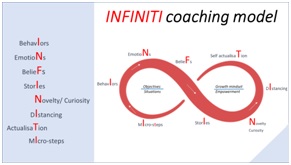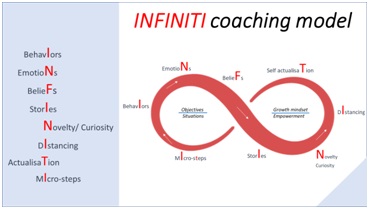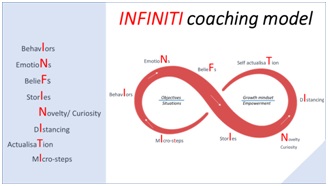A Coaching Model Created by Jean-Pierre Loizeau
(Executive Coach, FRANCE)
Introduction
In large organizations, talented people are spotted early in their careers. They are developed to build the next generation of leaders who will drive the future of the company. Young promising executives have detected thanks to numerous 360° feedback, assessment centers. They are also observed by HR as they present to key executives in business reviews (“B.R.”). Once detected, HR managers, meet them again several times to imagine and discuss possible career trajectories and structure a personal development plan. This plan is mainly built around experiences (appointment to new challenging positions) but also includes initiatives mainly in the field of education (training), Exposure (learning expeditions, shadowing other executives…).
The HR officers population driving these exercises is often composed of 2 types of profiles: HR officers who are either coming from technical, business, or support functions of the company or pure HR managers who most of the time have their agendas torn between compensation and benefits, labor relations, talent acquisition with other HR urgencies. In that context, most time or expertise is dedicated to supporting the building of “hard” competencies, through training or appointment to new positions to gain experience. In the best case, some soft sides are discussed and developed through exposure or training.
This leads to a paradox where while 360°, assessment, and observation of behaviors in B.R. very often loop back to developmental stakes connected to soft topics (self-awareness, self-development, emotional intelligence, cultivating an openness to learning and change, inspiring others to work with them, inducing a high level of collective intelligence in teams, developing team efficiency and resilience)little is done by HR to develop talents in these directions connected to the talent“self”, and its most critical soft challenges.
Fortunately, in some cases, talents are offered the support of a coach to address these self-development stakes. INFINITI model has a key role to play there as it offers Corporate HR internal coach, Talent Developers, or external coach a practical coaching model to explicit the coaching journey for these high potentials.
The Model
INFINITI
This model symbolizes the infinite universe of possibilities opening-up when talent connects with their inner-self. The driving principles are four-fold:
- Rise self-awareness on behaviors, emotions, beliefs, and narrative of self-journeys i.e. “stories”
- Leverage curiosity to explore other desirable self-stories and enlarge the vision of possibilities
- Distance self from own emotions, beliefs, self-stories to create new insights
- Accelerate self-actualization and initiate immediately micro changes
The coaching process aims at riding repeatedly the INFINITI model to maximize talent potential. The good side of the corporate world is that coaching situations cannot be a temptation for an internal or external coach. The setup of these large organizations generally includes several business or technical peers who can make themselves available to provide formal or informal mentoring to resolve issues and “coach concrete/events & action stories”. Therefore, the focus of coaching by external or internal HR coach is guarded against this evil of concrete/ events & action stories and easily focus only on the person. The word Stories used in the INFINITI model refers to a narrative of self, linking behaviors-emotions- beliefs. It allows the “coachee” to step back and examine its self-narrative transformation in connection to his/her higher purpose, and/or in connection to his/her best self and personal magic.
The ICF coaching structure is the backbone of successful coaching in corporate situations. The INFINITI model highlights the building blocks in the ICF approach that will create a shift in awareness and induce most progress to leaders being coached. It is also a model that they can gradually self-own to be able to self-observe themselves, step back in full autonomy: examine their behaviors, emotions, beliefs, and overarching belief narratives (stories), and look for inspiration in terms of novelty. They are then able to imagine how they could have more empowering overarching stories, how they could deliver on their aspiration of having a growth mindset, and then feel progress for themselves. The use of the INFINITI model creates a breed of leaders that self-actualize constantly when confronted with new context, circumstances, and challenges.
The role of leaders in companies is to inspire people to anticipate, benefit from the acceleration of change, communicate positive energy, enhance engagement. Leaders coached with the INFINITI model will be in a better position to transform themselves from that perspective. They will find in themselves resources to inspire people, culture, and organization changes for the firm to seize opportunities exactly as they emerge. Self-actualization and the art of updating or building new overarching stories for themselves are 2 critical skills at the center of the INFINITI model.

= Behaviors =
The coach creates a state of enhanced self-awareness around the coachee’s behaviors. The client will relate the actions he took, expressions used, the body language displayed at the moment. The client will be able to also to self-analyze the high-level decision-making process behind his/her actions. The goal in that part is for him/her to understand if it was an automatic [reflex-type decision without the intervention of thoughts or will] or a strategic [i.e. chosen in full consciousness] behavior and explore benefits and limitations.
3 key questions
- What did you do? What did your body language say? What did you tell?
- What were your automatic behaviors versus your strategic ones?
- What was the impact you had on others? How aligned was that impact with your aspirations?
In summary for the coachee: What is coming up?
= EmotioNs =
The coach will then create a state of enhanced self-awareness around the coachee’s emotions. The client will revisit the emotions he/she felt, the positive intent behind the self-emergence of that feeling, and the self-talk that came in connection to the emotions.
3 key questions
- What did you feel as you did/ behave/ say this?
- What was the positive intent behind the emergence of this emotion for yourself?
- What is the self-talk connected to the feeling? What part is absolute, maybe, clearly not true in that self-talk?
In summary for the coachee: What is coming up?
= BelieFs =
Progressing in the coaching process, the coach will enhance the client’s state of self-awareness by exploring the beliefs or representations connected to the emotions. The client will be invited to verbalize the belief, or the representation, making it then for him/herself an object to welcome positively, contemplate, explore, and observe.
3 key questions
- What is the representation/belief which is behind this feeling/self-talk?
- What made it such a powerful & benevolent belief/representation? How is it serving you now?
- How do the winds of change make you feel about this representation/belief?
In summary for the coachee: “What is coming up?”
= [behavior-emotions- belief]Narratives/Stories =
Continuing the coaching journey, the client will then explore the[behavior-emotions- belief]narrative or story he/she told her/himself around the event, trying to identify a possible pattern in these self-built overarching narrative/stories and the way they connect and integrate into the bigger story/picture of the client’s(life values, true-self, aspiring to life-narrative) and are also connected to the changes in the external world.
3 key questions
- If you were telling the[behavior-emotions- belief] story, what would this story be in 3 sentences?
- What are the similarities /pattern with other stories you told yourself recently?
- How does this story connect with the bigger story of your true self /movement forward? and your higher life purpose/ personal magic? with the changes in the external world?
= Novelty– Curiosity =
If the client does not spontaneously express her/himself around other possible [behavior-emotions- belief]stories, the coach will invite him/her to explore other stories: new ways of telling the same overarching story. The coach will be vigilant (of course) neither to validate the stories nor to express any judgment whatsoever.
Three key questions
- What radical new way of telling this[behavior-emotions- belief] story could you explore?
(The one you never dare to tell yourself?) - What are stories you heard people you admire tell themselves today when exposed to these events& emotions?
- In the world of tomorrow, how could these events & emotions narrative be told by someone from the emerging new world whom you find inspirational?
Distancingfrom [behavior-emotions- belief]story
This step opens the opportunity to:
Help the client self-distance from his/her current[behavior-emotions- belief] story by exploring the link between the story he just discovered, and his/her true self and the bigger story the client would want to tell with his/her life.
- If you reconnect to your true self, what does your true self tell you about the way you could frame this story so that it is more aligned with your true self?
- If you think about the story you would like to tell yourself when you retire (your movement forward, your magic?), how does this [behavior-emotions- belief]story fit into this overall story? What changes would you like to explore to keep the wisdom of this story but framing it differently?
- How could you transcend your story to keep the truth of the situation while respecting your true self and your magic?
It provides also an opportunity to practice direct communication with the client using metaphors to enquire: “ If I may – it might sound like “….”, what about that?”
Self-acTualization
3 key questions
- What would be the learning from this situation?
- What could you do by maximizing the use of this learning in your current situation?
- What learning could you bring from today’s session into the bigger picture of your life?
Interesting tools which might be available to the client to anchor key learning
- Morning intentions
- Daily Meditations
- Evening gratitude journal
Micro steps
The quick extreme change can cripple people into inaction. The most well-known example is the failure rate of 80% for the new year’s resolution.
Studies show that paralysis salesperson for 2 reasons:
Therefore, It is important to explore thoroughly with the client what he sees as being“what, when, where” to be done, and whether it is realistic and compatible with the ecosystem of his/her current life”. The meaning of each step for him needs also to be explored. Failure to do this may cause the client to lack the ability to truly ask him/herself if he/she is currently ready to make the necessary changes. He/she may find him/herself make& take every excuse under the sun to step away from their path.
Robert Maurer’s short book “One small step can change your life: the kaizen way” is inspiring to spark change. The author who is a clinical psychologist uses Kaizen to help people change their lives. (KAIZENis a discipline of continuous improvement in industrial processes, personal life, home life, social life, and working life.)
3 key questions
- If a long journey begins with a first step, what would be your first step?
- How could you hold yourself accountable for the first steps?
- How could you overcome things that might come in the way of these first micro steps?


Conclusion
Using the INFINITI model, the coachee will increase the client’s self-awareness and degree of self-empowerment in their life. In each session the client will surface his/her own stories of self, linking behaviors/emotions/beliefs together. When your client reconnects to his/her sense of true self and personal magic/movement forward, he or she will be able to revisit the link between the story linked to their objective, their usual pattern of stories, and the bigger story they are aspiring to.
Beyond being in a better posture to achieve their objectives through the use of the INFINITI model, the client will become gradually able to self-ask questions around his/her decision making patterns and the way he/she can progress in life by self-observation, self-reflection around emotions, self-talk, beliefs, stories and examine how they are serving them and imagine ways to transcend them.
INFINITI model will increase the client’s empowerment on his/her own decision making and uplift the sentiment of freedom versus the sentiment of fate. In a nutshell, it will allow them to accelerate their life journey by leveraging their growth mindset.
Bibliography
Inner Dynamics by Marilyn Atkinson
Laser-focused coaching by Marion Franklin
Emotional freedom by Jane Ault
Confidence, how to overcome your limiting beliefs and achieve your goals by Martin Meadows
https://positivepsychology.com/emotion-wheel/
https://radar.brookes.ac.uk/radar/items/50d60ec2-19e7-40eb-8ec1-5ab226abc32e/1/
Daily Love by Mastin Kipp
https://fs.blog/2017/01/making-a-change-one-small-step/
“One small step can change your life: the kaizen way”, The Kaizen Way, Robert Maurer PhD
https://www.psychologytoday.com/intl/blog/modern-mentality/201812/why-new-years-resolutions-fail